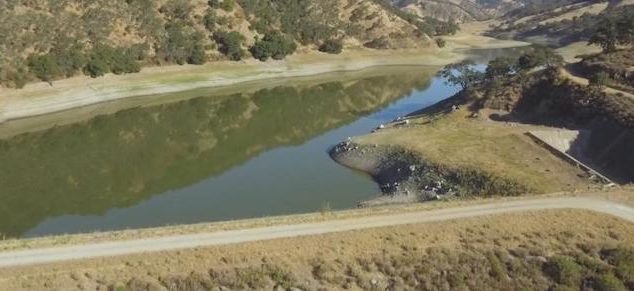News
After recent wet spell, thoughts turning anew to storage
 A view of the Pacecho Pass Reservoir. (Photo: Santa Clara County Water District)
A view of the Pacecho Pass Reservoir. (Photo: Santa Clara County Water District)Is California’s drought coming to an end?
Experts say no, not yet, despite the recent historic levels of rain and snow throughout the state.
And while 2021 was the driest in California in a century, 2022 is giving people hope that the seemingly interminable drought may finally be over, at least for now, following record-breaking snows along the linchpin of California’s water supply, the Sierra Nevada.
It is also heightening the discussion over whether new reservoirs should be built, and nowhere is that discussion more intense than in Santa Clara County, population 1.9 million.
UC Berkeley’s Central Sierra Snow lab reported that December has been the snowiest since December of 1970 and residents of the Sierra Nevada — which, appropriately, means “snowy mountain range” in Spanish — probably won’t argue with that. An estimated 75 percent of Californians drink water that originates in the region.
With a number of highways, including major east-west links like I-80, being closed and lengthy power outages, the white fluffy snow quickly became an enemy for the holiday season.
Two weeks after the storms, some 3,200 homes remained without power in Nevada, Placer, El Dorado and Sierra counties.
Currently all 58 counties in the state are under some type of drought emergency proclamation. However, with the recent storms precipitation has averaged 150% to 300% percent of normal or more throughout nearly all of California, and the state’s mountain snow holds more than 160% of what it normally does this time of year as well.
When it comes to water, some counties are lucky with water but others — not so much.
Santa Clara County, for example, has always had its water issues. Like many in California, it is largely relies on water from the Sacramento-San Joaquin River delta, and draws water from the the San Luis Reservoir, an imposing inland man-made lake off Highway 152 in the Pacheco Pass, and other sources.
But as the drought intensified, the San Luis Reservoir level dropped. As of Monday, Jan. 10, the level of San Luis was 415 feet, measured from seat level, up from the 341 feet measured during October.
“The reservoir’s water quality goes down when water levels are low,” noted Professor Jay Lund of the Center for Watershed Sciences at UC Davis.
Because of the all this and more, Santa Clara authorities are considering another reservoir, the Pacheco Pass Expansion Project, and the proposal is gaining traction.
The plan, in conjunction with the Pacheco Pass Water District and the San Benito County Water District, is to build a $2.3 billion dollar dam in the hills of southern Santa Clara County. It would be the largest new reservoir constructed in the Bay Area in more than 20 years.
A Pacheco Pass Reservoir already exists, with a capacity of 5,500 acre-feet; the expanded reservoir would increase the capacity to 140,000 acre-feet, “enough to supply 1.4 million people with safe, clean water for one year in an emergency,” the Santa Clara Water District said last month. (An acre-foot of water is the amount needed to cover one acre to a depth of one foot, or about 330,00 gallons, roughly the yearly amount used by a family of four.)
The expanded reservoir would be filled by a combination of rainfall, runoff from the watershed upstream of the new dam, and imported water supplies. The water released from the reservoir will help threatened fish by keeping the Pacheco Creek flowing, before seeping into the underlying groundwater aquifer as it winds toward where it meets the Pajaro River.
While the project is just coming to fruition and still isn’t fully approved, the California Water Commission reported last month that the project continues to qualify for nearly half a billion dollars in state funding.
While this may be great news to some, California’s Sierra Club and other environmentalists were skeptical.
“Construction of the reservoir will flood a 13,200 acre area that currently contains valuable wetland and oak woodland habitat. To fill the reservoir, the project will divert water from the Sacramento River, one of the main tributaries to the San Francisco Bay-Delta,” the Sierra Club noted.
Other concerns included not providing the benefits to the ecosystem and water quality conditions required by Water Storage Investment Program Regulations and not providing specific mitigation and conservation measures for the significant environmental impacts, among other things.
—
Editor’s Note: Uriel Espinoza-Pacheco is a Capitol Weekly intern from The Met Sacramento.
Want to see more stories like this? Sign up for The Roundup, the free daily newsletter about California politics from the editors of Capitol Weekly. Stay up to date on the news you need to know.
Sign up below, then look for a confirmation email in your inbox.

Leave a Reply